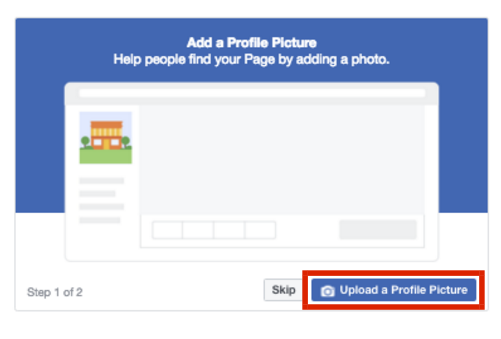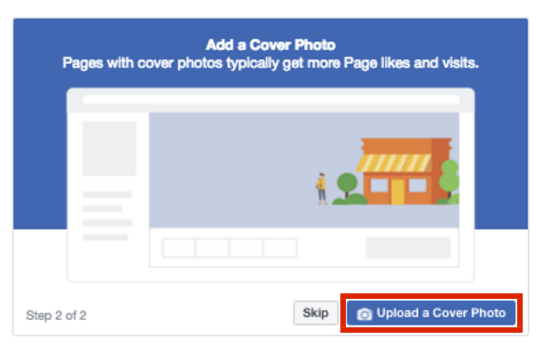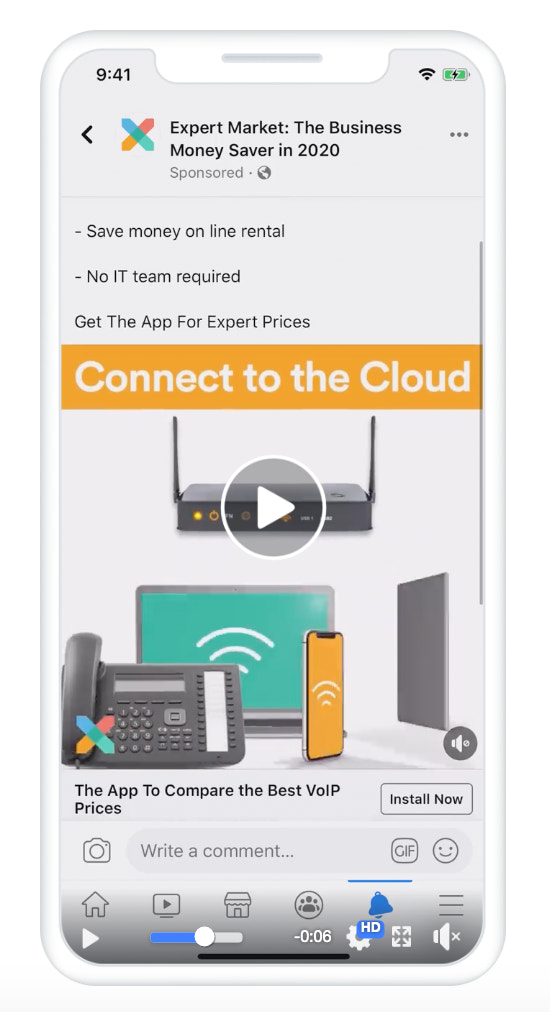3. Upload Your Profile Picture & Cover Photo
Next, choose a photo to upload as your business page profile picture. Businesses commonly use their logo as a profile picture, but you may use any photo that represents your business and your business’ branding. Be sure that your image is clear and doesn’t get cropped.
If you don’t already have an image in mind that you’d like to use, or are in need of a new one, it’s worth checking Bluehost. There you can find freelance experts who can design a professional profile picture for you, whether it’s a logo another image, at an affordable price.
Next, consider uploading a cover photo. A cover photo is the background image that appears on your Facebook Business Page, similar to your personal Facebook account. You want your cover photo to be visually appealing and representative of your business. Your cover photo should be at least 400 pixels wide by 150 pixels tall. You can check out our list of Facebook page templates for your small business.
If you are having trouble finding a cover image, you can create one for free using Canva. It includes many Facebook cover templates that you can easily customize without any graphic design skills or knowledge. For more information, check out our guide on how to design a Facebook business page.
How to advertise on Facebook in 6 steps
Step 1: Set up your Meta Business Suite (formerly Facebook Business Manager)
Many of the people who give up on their Facebook advertising efforts do so because they set up their account incorrectly or become so overwhelmed by Facebook’s myriad ad options that they never make it to the point of actually running a campaign.
Step 2: Install the Meta pixel
One of the most common frustrations among new Facebook advertisers is understanding whether or not their ads actually worked. It’s possible to boost a post or even set up an advertising campaign in Ads Manager, but without installing the Meta pixel you won’t know whether an ad drove any sales on your website.
The Meta pixel is the connection point between your Facebook ads and your website. The pixel is a tracking code you need to create within your Meta Business Suite account and then add to your website before you begin paying for ads. It shows you all the actions being taken by visitors coming to your website through your Facebook ads. Essentially, the Meta pixel tells you not only if your ads drove results but which specific audiences and pieces of creative those conversions came from.
Setting up your Meta pixel in Shopify
If you’re using Shopify, setting up your Meta pixel is as easy as copying your pixel ID (a 16-digit number) from your Meta Business Suite account and pasting it into the Meta pixel ID field, located under Online Store in the preferences section of your Shopify store.
You should start seeing your website’s activity within a few hours of adding your pixel ID to your Shopify store. Stats such as visitors, add to carts, and purchases are recorded in your Meta Business Suite account under Pixels.
Step 3: Create Facebook audiences
Targeting the right people with your ads is one of the keys to being successful with Facebook advertising. Facebook has billions of users worldwide, so finding those most likely to be interested in your brand or product requires the use of Facebook’s audiences feature.
Audiences is a section within Meta Business Suite where you can create lists of people to target with your ads. There are several different features available within the audiences section to help you define these lists, but they can be divided into two broad categories: retargeting and prospecting.
Retargeting: Converting warm audiences
Someone who has visited your website, added something to their cart, or followed you on Instagram is more likely to consider buying something from you—they might just need a little encouragement.
If you’ve ever browsed a brand’s website and then found yourself targeted by its ads every time you open Facebook or Instagram, that’s called “retargeting,” and it’s one of the most effective forms of Facebook advertising.
You can create Facebook retargeting audiences using the Custom Audiences feature, located in the Audiences section of Meta Business Suite. Facebook offers you the option to tap into all the data captured by your Meta pixel and business pages through Custom Audiences.
When creating a Custom Audience, you are given a list of different sources to draw from. The three main sources ecommerce businesses will want to use are customer list, website, catalog.
Customer file allows you to upload a list of email addresses, phone numbers, and any other contact information you’ve collected from customers or leads. Facebook matches this information back to its own users so you can target them directly with your ads.
Website traffic allows you to create a retargeting list for reaching your website visitors. Here, you can create lists of various sizes based on actions taken or pages visited on your website. Common retargeting lists that generally convert well include those who visited your website in the past 30 days or added something to their cart in the past seven.
Prospecting: Finding new customers
Looking for new customers is often referred to as “prospecting” and involves advertising to those who have not purchased from you or interacted with your business online. For small and medium-sized businesses, this encompasses the majority of Facebook’s billions of active users, and deciding how to start narrowing down that list can be difficult.
One way Facebook finds good prospects for your business is by using a list of customers or leads you’ve already collected. Lookalike Audiences use the data from your Custom Audiences to create a new audience filled with Facebook users that share similarities with your existing customers.
Types of Facebook ads
Your success in Facebook advertising depends on your objective and the type of ad you use. Producing effective, high-performing ads, however, presents a challenge for many beginners because there are so many different types to choose from.
Image
Single image ads are the standard for Facebook advertising. They are easy to make, offer a clean format for you to promote your brand, and are one of the most effective ad formats. In one Facebook study, a series of photo-only ads outperformed other ad formats in driving unique traffic.
Image ads are best for when you want to create an ad quickly or don’t have much of a budget. You can create an image ad right from your Facebook page as a boosted post, or if you want more detailed targeting options, you can make one in Facebook Ads Manager.
Video
Video ads let you show off your product or brand and capture viewers’ attention in the feed. You can create video ads in Facebook Ads Manager or boost a post that has a video from your Facebook page. These ads appear on Facebook, Instagram, and Messenger.
You can use Facebook video ads to show unique features or tell your brand’s story. Videos that are 15 seconds or less can help capture your audience and keep them engaged. They should also have a clear call to action (CTA) at the end, such as purchasing a product or visiting a website.
Carousel
Carousel ads let you include up to 10 images or videos in a single ad, each with its own link. People can scroll through the carousel by swiping left or right on their devices or by clicking directional arrows if using the desktop client.
Collection
The collection ad format includes a full-screen Instant Experience to make it easier for people to browse and buy your products. These ads include a cover image or video and can show multiple products underneath.
Collection ads are a great way to show off your product catalog, offer an enjoyable browsing experience, and help turn interest into sales. You can show these ads across the Facebook feed, Instagram’s feed, and even Instagram Stories.
How to Make Your Facebook Group Successful
How to Prevent Spam in Your Facebook Group
Spam can quickly kill a group. No one likes to receive messages that are not going to be of use to them or that are just overly self-promotional. Don’t make your good group members abandon ship due to spam.
If you see someone post something that resembles spam, send them a direct message and let them know that what they’re doing is against the group rules. If they continue to abuse the rules, kick them out.
It takes a little bit of monitoring to keep your group enjoyable for all, but it’s well worth it in the end. To make your rules really obvious, I recommend creating a pinned post that explains all of the rules in detail.
Potentially engaged users may find it offputting to have to wait for their post to show up, and monitoring and approving every single post is going to take up a lot of your time.
More often than not, there will be someone within the group who will be happy to do this for you for free because they see it as giving themselves authority within the group by helping out.
These groups sprung up organically by people looking to sell and buy items. The popularity of them caused Facebook to introduce the official “Buy & Sell” group type, which gives groups additional features like prices and for sale listings.
To combat this, large groups often have 20 or more admins monitoring posts and keeping things fair. These large groups, often with 50,000 members or more, function like small cities, and the admins are the court justices and police officers keeping them running.
Encourage Engagement
Use Polls to Drive Facebook Group Engagement
For my Labrador Group, I might ask that people share a picture of their beloved Lab when they join. People love sharing photos of their pets, so it’s a pretty easy thing to ask them to do.
Use Theme Days
Offer Exclusive Facebook Group Content
This is similar to the approach you’d take with gated content that I mentioned earlier. However, instead of having a post that leads to your group, you’re producing content to improve retention within the group.
Grow Your Facebook Group Engagement with Live Video
An interesting statistic is that users watch live videos 3 times longer than they would watch a recording, signaling that people get really invested in what’s happening ‘in the moment’ and want to find out what happens next.
She delivers valuable content, with many videos exceeding 20 minutes in length, and answers her members’ questions in real time. She also does a good job of linking over to her website to encourage new registrations.
Video goes a long way toward establishing trust. When your audience can see you, especially live, they are much more inclined to connect with you and see you as a credible and trustworthy person.
Conclusion
Maintaining a group can take just as much time as marketing it in the beginning. You’ll have to deal with approving members, monitoring and deleting spam, and enforcing group rules.
Share
He is the co-founder of NP Digital. The Wall Street Journal calls him a top influencer on the web, Forbes says he is one of the top 10 marketers, and Entrepreneur Magazine says he created one of the 100 most brilliant companies. Neil is a New York Times bestselling author and was recognized as a top 100 entrepreneur under the age of 30 by President Obama and a top 100 entrepreneur under the age of 35 by the United Nations.
Sources:
https://www.entrepreneur.com/article/309107
https://www.shopify.co.id/blog/facebook-ads
https://neilpatel.com/blog/an-eye-opening-guide-create-grow-facebook-group/





















